1. Baker MA. The management of leukaemia in the elderly. Baillieres Clin Haematol 1987;1:427–448PMID : 3322444.


2. Delannoy A, Ferrant A, Bosly A, et al. Acute lymphoblastic leukemia in the elderly. Eur J Haematol 1990;45:90–93PMID : 2209825.


4. Thomas X, Olteanu N, Charrin C, Lheritier V, Magaud JP, Fiere D. Acute lymphoblastic leukemia in the elderly: The Edouard Herriot Hospital experience. Am J Hematol 2001;67:73–83PMID : 11343378.


5. Robak T, Szmigielska-Kaplon A, Wrzesien-Kus A, et al. Acute lymphoblastic leukemia in elde rly: the Polish Adult Leukemia Group (PALG) experience. Ann Hematol 2004;83:225–231PMID : 14648030.


6. Virgilio JF, Moscinski LC, Ballester OF, et al. Acute lymphocytic leukemia (ALL) in elderly patients. Hematol Oncol 1993;11:121–126PMID : 8112726.


7. Kantarjian HM, O'Brien S, Smith T, et al. Acute lymphocytic leukaemia in the elderly: characteristics and outcome with the vincristine-adriamycin-dexamethasone (VAD) regimen. Br J Haematol 1994;88:94–100PMID : 7803263.


8. Spath-Schwalbe E, Heil G, Heimpel H. Acute lymphoblastic leukemia in patients over 59 years of age: experience in a single center over a 10-year period. Ann Hematol 1994;69:291–296PMID : 7993936.


9. Ferrari A, Annino L, Crescenzi S, Romani C, Mandelli F. Acute lymphoblastic leukemia in the elderly: results of two different treatment approaches in 49 patients during a 25-year period. Leukemia 1995;9:1643–1647PMID : 7564503.

10. Bassan R, Di Bona E, Lerede T, et al. Age-adapted moderate-dose induction and flexible outpatient postremission therapy for elderly patients with acute lymphoblastic leukemia. Leuk Lymphoma 1996;22:295–301PMID : 8819079.


11. Delannoy A, Sebban C, Cony-Makhoul P, et al. French Group for Treatment of Adult Acute Lymphoblastic Leukemia. Age-adapted induction treatment of acute lymphoblastic leukemia in the elderly and assessment of maintenance with interferon combined with chemotherapy: a multicentric prospective study in forty patients. Leukemia 1997;11:1429–1434PMID : 9305593.


12. Shin HC, Na II, Yun T, et al. Acute myelogenous leukemia in the elderly (>or=60): retrospective study of 115 patients. Korean J Med 2006;70:196–206.
13. Boucheix C, David B, Sebban C, et al. French Group on Therapy for Adult Acute Lymphoblastic Leukemia. Immunophenotype of adult acute lymphoblastic leukemia, clinical parameters, and outcome: an analysis of a prospective trial including 562 tested patients (LALA87). Blood 1994;84:1603–1612PMID : 8068949.


14. Linker CA, Levitt LJ, O'Donnell M, Forman SJ, Ries CA. Treatment of adult acute lymphoblastic leukemia with intensive cyclical chemotherapy: a follow-up report. Blood 1991;78:2814–2822PMID : 1835410.


15. Mandelli F, Annino L, Rotoli B. GIMEMA Cooperative Group, Italy. The GIMEMA ALL 0183 trial: analysis of 10-year follow-up. Br J Haematol 1996;92:665–672PMID : 8616033.


16. Kantarjian HM, O'Brien S, Smith TL, et al. Results of treatment with hyper-CVAD, a dose-intensive regimen, in adult acute lymphocytic leukemia. J Clin Oncol 2000;18:547–561PMID : 10653870.


18. Leith CP, Kopecky KJ, Godwin J, et al. Acute myeloid leukemia in the elderly: assessment of multidrug resistance (MDR1) and cytogenetics distinguishes biologic subgroups with remarkably distinct responses to standard chemotherapy. A Southwest Oncology Group study. Blood 1997;89:3323–3329PMID : 9129038.


19. Taylor PR, Reid MM, Proctor SJ. Acute lymphoblastic leukaemia in the elderly. Leuk Lymphoma 1994;13:373–380PMID : 8069181.


20. Kantarjian H, Thomas D, O'Brien S, et al. Long-term follow-up results of hyperfractionated cyclophosphamide, vincristine, doxorubicin, and dexamethasone (Hyper-CVAD), a dose-intensive regimen, in adult acute lymphocytic leukemia. Cancer 2004;101:2788–2801PMID : 15481055.


21. Secker-Walker LM, Prentice HG, Durrant J, Richards S, Hall E, Harrison G. MRC Adult Leukaemia Working Party. Cytogenetics adds independent prognostic information in adults with acute lymphoblastic leukaemia on MRC trial UKALL XA. Br J Haematol 1997;96:601–610PMID : 9054669.


22. Larson RA, Dodge RK, Linker CA, et al. A randomized controlled trial of filgrastim during remission induction and consolidation chemotherapy for adults with acute lymphoblastic leukemia: CALGB study 9111. Blood 1998;92:1556–1564PMID : 9716583.

23. Delannoy A, Cazin B, Thomas X, et al. Treatment of acute lymphoblastic leukemia in the elderly: an evaluation of interferon alpha given as a single agent after complete remission. Leuk Lymphoma 2002;43:75–81PMID : 11908739.


24. Bao L, Gross SA, Ryder J, et al. Adult precursor B lymphoblastic leukemia in Shanghai, China: characterization of phenotype, cytogenetics and outcome for 137 consecutive cases. Int J Hematol 2009;89:431–437PMID : 19322628.


25. Westbrook CA, Hooberman AL, Spino C, et al. Clinical significance of the BCR-ABL fusion gene in adult acute lymphoblastic leukemia: a Cancer and Leukemia Group B Study (8762). Blood 1992;80:2983–2990PMID : 1467514.


26. Thomas X, Thiebaut A, Olteanu N, et al. Philadelphia chromosome positive adult acute lymphoblastic leukemia: characteristics, prognostic factors and treatment outcome. Hematol Cell Ther 1998;40:119–128PMID : 9698220.

27. Gleissner B, Gökbuget N, Bartram CR, et al. Leading prognostic relevance of the BCR-ABL translocation in adult acute B-lineage lymphoblastic leukemia: a prospective study of the German Multicenter Trial Group and confirmed polymerase chain reaction analysis. Blood 2002;99:1536–1543PMID : 11861265.


29. Moorman AV, Harrison CJ, Buck GA, et al. Karyotype is an independent prognostic factor in adult acute lymphoblastic leukemia (ALL): analysis of cytogenetic data from patients treated on the Medical Research Council (MRC) UKALLXII/Eastern Cooperative Oncology Group (ECOG) 2993 trial. Blood 2007;109:3189–3197PMID : 17170120.


30. Jang SN, Kim DH. Trends in the health status of older Koreans. J Am Geriatr Soc 2010;58:592–598PMID : 20398125.





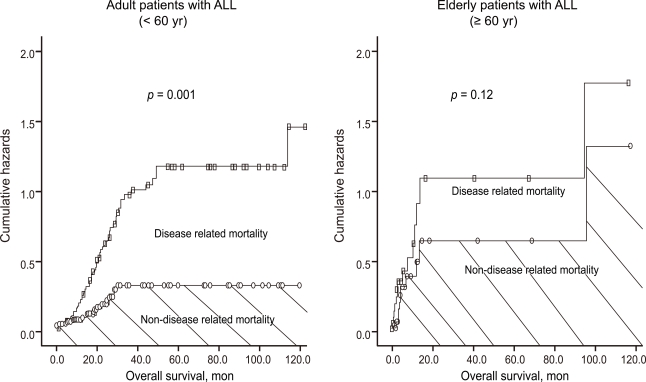
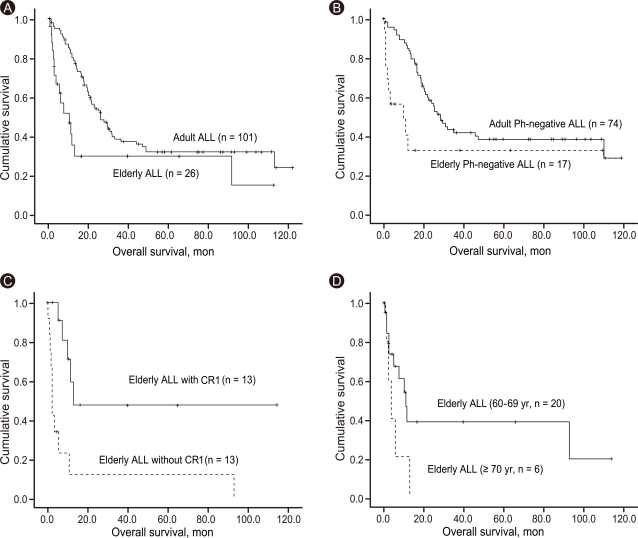
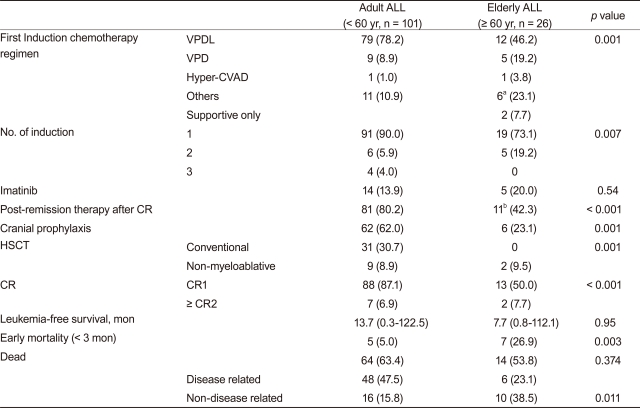




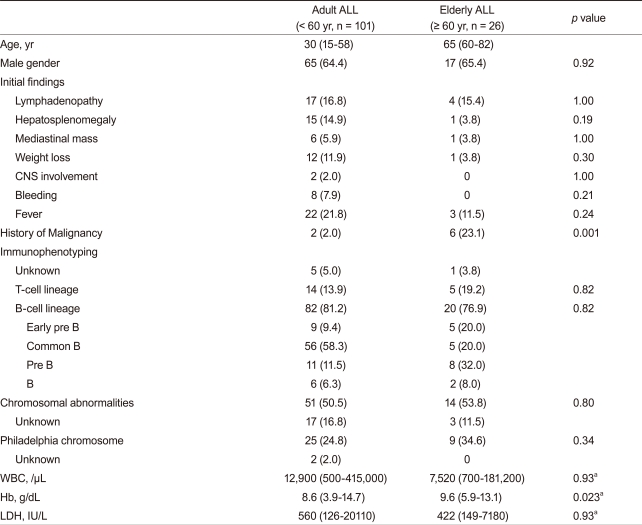
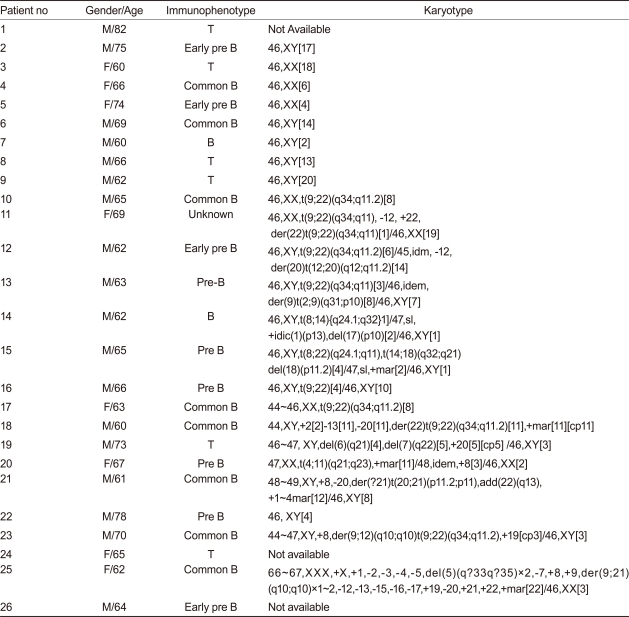


 PDF Links
PDF Links PubReader
PubReader ePub Link
ePub Link Full text via DOI
Full text via DOI Download Citation
Download Citation Print
Print



